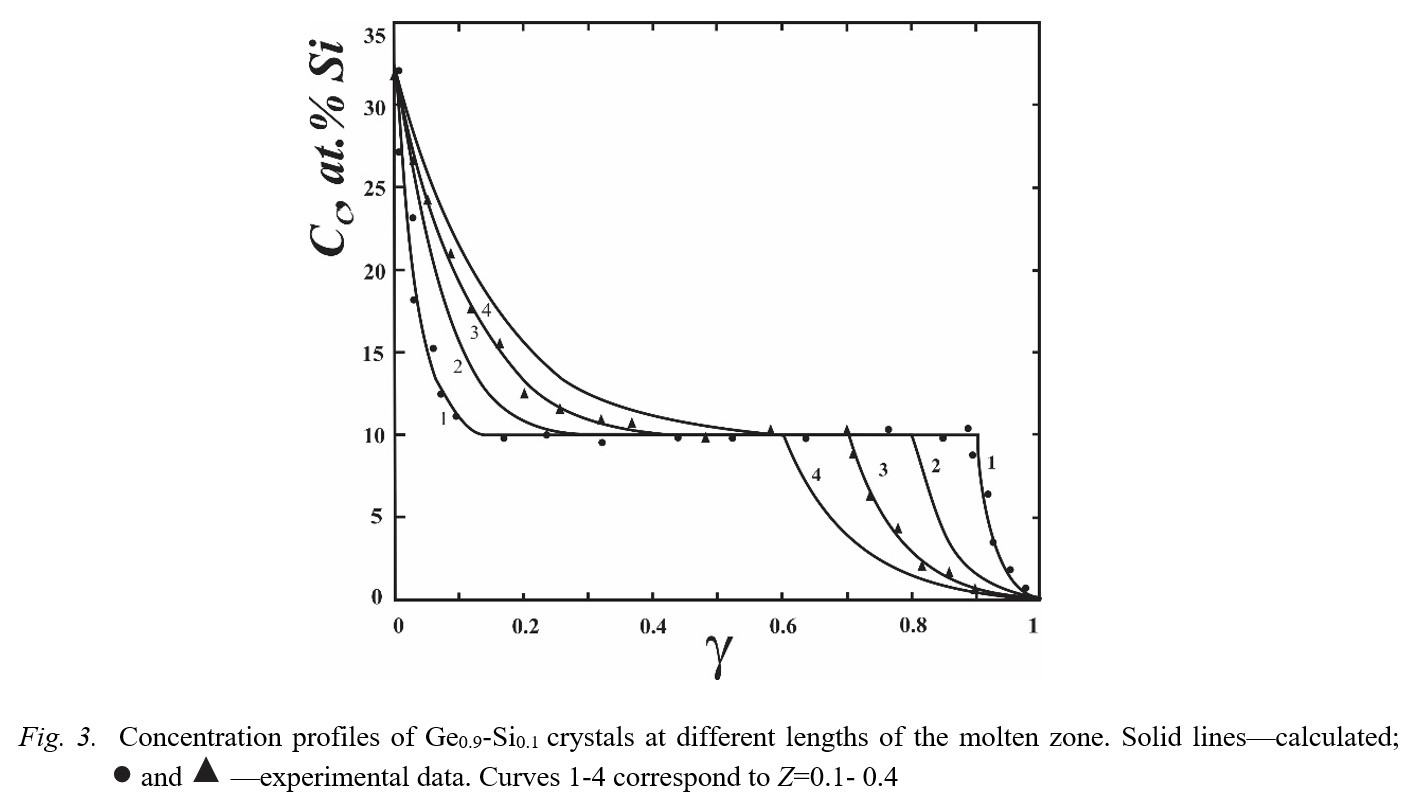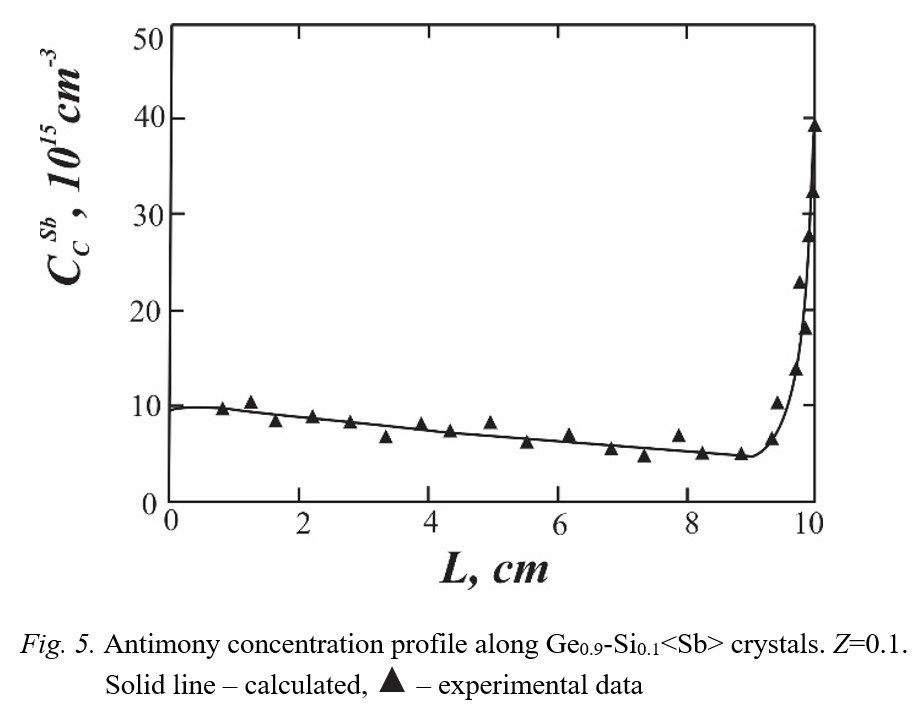ABSTRACT
In the Pfann approximation, mathematical calculations were carried out on the distribution of the main components and impurities in germanium-like
Ge(1-x)-Si(x)<Ga>
and Ge(1-x)-Si(x)<Sb> crystals, grown by the zone melting method. Using this method, Ge0.9-Si0.2<Ga> and Ge0.9-Si0.2<Sb>
crystals were obtained at different lengths of the molten zone and their concentration profile was studied. Comparison of calculated and experimental data indicates their
good agreement. This makes it possible to conclude that with the help of mathematical modeling it is possible within wide limits regulate the concentration profile of the
main components and impurities in Ge-Si crystals grown by the zone melting method using different length of the molten zone and choosing the composition of the initial
polycrystalline rod.
Keywords: semiconductor, Ge-Si, zone melting, Ga, Sb
DOI:10.70784/azip.1.2024221
Received: 24.05.2024
Internet publishing: 28.06.2024
AUTHORS & AFFILIATIONS
Institute of Physics under the Ministry of Education and Science of Azerbaijan Baku, AZ-1143, H. Javid Ave. 133, Azerbaijan
E-mail: islamzadeelnara@gmail.com
Graphics and Images





Fig.1 Fig.2 Fig.3 Fig.4 Fig.5
|
REFERENCIES
[1] N.V. Abrosimov, et al. 1997. Czochralski growth of Si- and Ge-rich Si-Ge single crystals. J. Cryst, Growth, 174(1–4), 182–186. DOI: https://doi.org/10.1134/S0020168507010025
[2] S. Adachi. et al. 2005. Homogeneous SiGe crystals grown by using the traveling liquidus-zone method. J. Cryst. Growth., 280(3–4), 372–377.
[3] Z.A. Aghamaliyev, et al. 2016. Modeling the Distribution of Ga and Sb Impurities in Ge-Si Single Crystals Grown by Double Feeding of the Melt: Growth Conditions for Homogeneous Single Crystals. Crystallography Reports,61(2), 327–330. https://doi.org/10.1134/S1063774516020024
[4] W. Ashcroft Neil, and N. Mermin. 1976. Solid state physics. New York : Saunders College Publishing,. - ISBN 0-03-083993-9.
[5] G.Kh. Azhdarov, et al. 2014. Hybrid technique for growing homogeneous single crystals of semiconductor solid solutions from melt. Crystallography Reports, 59(3) 442–445. https://doi.org/10.1134/S1063774514020059
[6] G.Kh. Azhdarov, et al. 2001. Distribution of components in Ge–Si bulk single crystals grown under the continuous feeding of the melt with the second component (Si). J. Cryst. Growth, 226(4), 437–442. https://doi.org/10.1016/S0022-0248(01)01270-2
[7] G.Kh. Azhdarov, et al. 2009. The distribution of Ga and Sb impurities in Ge–Si crystals grown by the Bridgman method using a feeding rod. Crystallogr. Rep., 54(1), 150–153. https://doi.org/10.1134/S106377450901026X
[8] Bok-Cheol, Sim. et al. 2006. Boron segregation control in silicon crystal ingots grown in Czochralski process. J. Cryst. Growth., 290(2), 665–669.
[9] V.K. Kyazimova, et al. 2006. Distribution of aluminum and indium impurities in crystals of Ge–Si solid solutions grown from the melt. Crystallogr. Rep., 51(1), S192–S195. https://link.springer.com/article/10.1134/S1063774506070273
[10] C. Marin, and A.G. Ostrogorsky. 2000. Growth of Ga-doped Ge0.98Si0.02 by vertical Bridgman method with a baffle. J. Cryst. Growth, 211(1–4), 378–383. DOI:10.1016/S0022-0248(99)00825-8
[11] M. Yildiz, et al. 2005. Growth of bulk Si-Ge single crystals by liquid phase diffusion. J. Cryst. Growth, 280(1–2), 151–160. https://doi.org/10.1016/j.jcrysgro.2005.03.030
[12] I. Yonenaga. 2005. Growth and fundamental properties of SiGe bulk crystals. J. Cryst. Growth, 275(1–2), 91–98. https://doi.org/10.1016/j.jcrysgro.2004.10.071
[13] I. Yonenaga, and T. Ayuzava. 2006. Segregation coefficients of various dopants in SixGe1–x (0.93 <x >0.96) single crystals. J. Cryst. Growth, 297, 14–19. https://doi.org/10.1016/j.jcrysgro.2006.08.044
[14] П.Г. Аждаров, и др. 2009. Моделирование распределения компонентов в твёрдых растворах InSb-GaSb, выращенных методом зонной плавки. Trancactions of ANAS, physics and astronomy, 29(5), 121–124.
[15] В.М. Глазов, и В.С. Земсков. 1967. Физико-химические основы легирования Полупроводников. Москва: «Наука».
|
